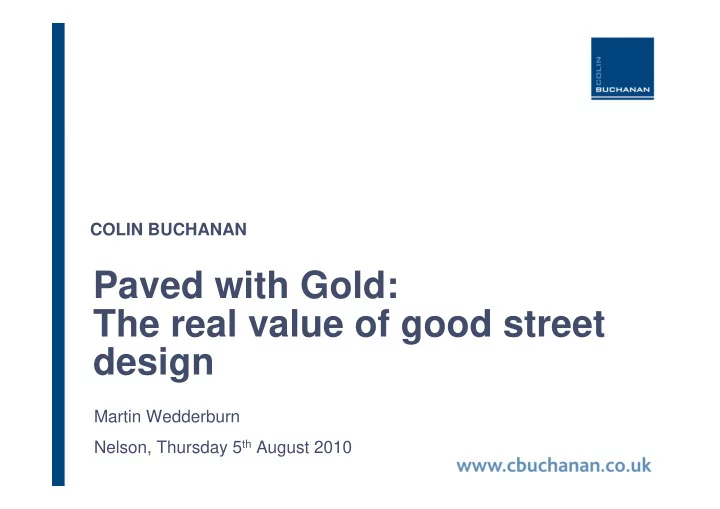

COLIN BUCHANAN Paved with Gold: The real value of good street design Martin Wedderburn Nelson, Thursday 5 th August 2010 Colin Buchanan
Case studies Making the case Prioritising Monitoring investment Demand What works forecasting for walking?
Making the case: A toolkit for valuing walking
Where should I spend my money? Waterview connection Cost: $2.912m Benefit: $3.370m User benefits $28m Wider benefits $0 Revenue BCR: 1.15:1
Where should I spend my money? Town centre enhancement Cost: $15m Benefits: “It’s a good thing to do” BCR: ?? School Travel Plans Cost: $1.5m Benefit: “Probably positive” BCR: ??
How? Cost savings Stated preference Hedonic pricing Secondary benefits
Measuring quality Can we measure walkability ? Quality audits (PERS, community street review) Numerical measurements, e.g. layout (accessibility, legibility), access to green space
Climate change Mode shift Embedded emissions Adaptation (drainage, shade)
Economic growth Local connectivity Clustering Local property prices Retail performance
Equality of opportunity
Quality of life and environment
Safety, security and health Road safety Physical activity Mental health Air quality Crime
Business case 1: Tottenham Hale
Business case 2: River crossings
Carter Lane Quarter Business case 3:
Prioritising investment: The pedestrian barriers project
Background
Demand and facilities Generally positive Potential ‘High demand & relationship poor facilities’ between demand demand and provision ‘Good facilities & low demand’ Quality of crossing provision
Calibration - demand
Calibration - facilities
Quality of crossings Generalised journey time: Horizontal deflection Vertical deflection Delays
Predicting pedestrian routes
Findings
Demand forecasting : A recent example
Background Opportunity Area: Battersea Power Station US embassy High density mixed use developments Green space Transport network upgrades
Movement forecasting Our approach: Link to strategic outputs Public realm Layout variables Activity and movement
Movement forecasting
Calibrated model Movement forecasting Observed
Applications Scenario testing Capacity Crossing design Security Retail Business case inputs
Improving routes : What works for walking?
5 recommendations 1. Getting the basics right 2. Personal security 3. Safe and direct routes 4. Dwell and rest spaces 5. Capacity
1. Getting the basics right Cleanliness Maintenance & Materials
1. Getting the basics right Accessibility Simple but effective innovation
2. Personal security
3. Safe and direct routes UK design guidance for residential development New street design philosophy?
3. Safe and direct routes
3. Safe and direct routes – guard rail
3. Safe and direct routes - crossings
4. Dwell and rest spaces
4. Dwell and rest spaces Natural meeting points Next to main flow Facing main flow / activity Protected back Adaptable space
5. Capacity – vehicular vs. pedestrian Similar: Different: Finite capacity Not always linear Movement flows Waiting to cross and stationary Role of place Queues can functions block other flows
Level of Service
Micro-simulation
Monitoring: Best practice in data collection
Measuring pedestrian activity What doesn’t count isn’t counted… and what isn’t counted doesn’t count.
Objective “ Establishing a set of international guidelines for the collection, analysis and dissemination of quantitative and qualitative techniques for measuring walking.” (WALK21 conference conclusions Melbourne 2006)
What can we measure?
Pedestrian activity
Pedestrian activity
User characteristics
Behaviour
Perceptions
Case study: Strategic Walks Network Annual performance indicators: User numbers User characteristics Walking patterns User satisfaction Awareness and promotion
Discussion
Recommend
More recommend